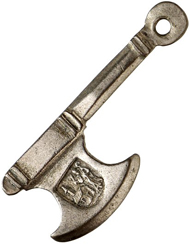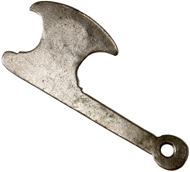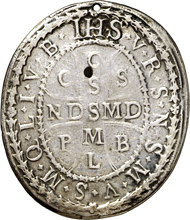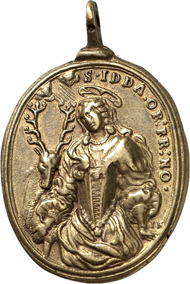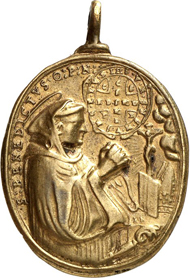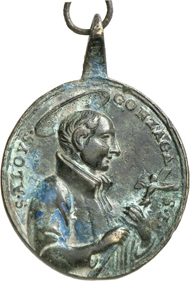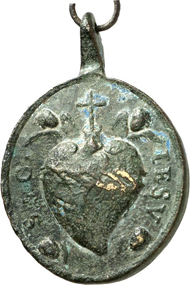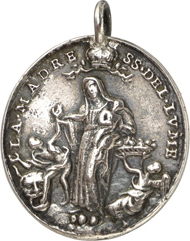On 16 October, 2014, Gorny & Mosch will auction off the collection of Werner Jaggi (1927-2002) in Munich with auction sale #226. Over the course of several decades, the distinguished expert on religious art mainly of the Alpine region assembled the largest collection of numismatic testimonies on religious beliefs and customs the market has ever seen. After the natural sciences have explained the world to us, we have lost the understanding of the unconditional belief that is expressed in these objects. Hence, only few people can still appreciate what a gnadenpfennig or an amulet may have meant to its wearer back then.
In the first part we focused on gnadenpfennige from Germany. Today we cover Austria, Switzerland and Italy.
Austria
3214: Abersee, Sankt Wolfgang. Cast silver ‘Wolfgangs-Hackerl’, 18th cent. with the depiction of the church in deep relief l., to the r. Bishop Wolfgang with crozier and axe. With two loops. 41.5 mm. Pachinger 86. Fine to very fine. Estimate: 75 euros.
Anyone looking at the streams of tourists present at the Wolfgangsee becomes aware of the fact that the municipality of St. Wolfgang has a pilgrimage destination until the present day: the White Horse, after the international success of the musical comedy bearing the same name, is now attracting all the tourists that might have paid tribute to St. Wolfgang in earlier times.
Wolfgang used to be politically very active before he felt the desire to withdraw as a hermit. When he was looking for a suitable spot he is said to have thrown the axe (Austrian: ‘Hackerl’). The spot where the axe landed he chose as his cell, which is the very place where the church St. Wolfgang in the municipality of the same name is located. He who went on a pilgrimage to this site in the previous centuries, made sure of buying a ‘Wolfgangs-Hackerl’, because that amulet averted sudden death, strokes, lower back pain, gout, dysentery, even snake bites and evil demons, to name but a few areas of application. In order to activate the powers of the amulet, one had to let it drop behind the bars of the original chapel. Afterwards the communion chalice, attributed to St. Wolfgang and kept in the sacristy, had to be touched with it. The priest present said a few words of consecration and therewith completed the act of activating the amulet.
3231: Nonnberg near Salzburg. Silver pendant, upright oval, c. 1682 from the Seel workshop. Bust reliquiary of St. Ehrentrud of Nonnberg, signed P-S. Rev. Shield of St. Benedict. 38×33.5 mm. Holed, to be worn. Very fine. Estimate: 100 euros.
There is not much information available on St. Erentrudis who served as first abbess of the Benedictine abbey of Nonnberg in the early 7th century, and hence became patron saint of Salzburg. Together with her uncle, St. Rupert of Worms, she came to Salzburg, to die there, in the Nonnberg Abbey, on 30 June, 718. We know that a pilgrimage was instituted in her honor as early as 788. She was venerated as particularly efficient curer of headaches and cattle plagues. It was, however, in the times of the Counter Reformation that Ehrentrudis’ importance reached its zenith. Her mortal remains were translated to the enlarged church of the abbey on 4 September, 1624, in a festive ceremony. In the years to follow, that day was celebrated with a procession and a festive sermon. This is also the time the remarkable crown of the bust reliquary – dating from Gothic times, to be exact – was made depicted on our silver pendant.
The reverse of it shows the blessing of St. Benedict, with which Saint Benedict of Nursia allegedly had made the poisoned chalice handed to him in Vicovaro burst. The letters CSSML stand for Crux sacra sit mihi lux (= May the holy cross be my light!), NDSMD for non draco sit mihi dux (= May the dragon = devil never be my overlord!). Forming a cross the letters CSPB translate as Crux Sancti Patris Benedicti (=The Cross of [our] Holy Father Benedict).
In early modern times, the blessing of St. Benedict was used for many purposes. In the purse it prevented counterfeit money and fraud; in the foundation of a building it averted high floods and avalanches. When attached to the cowbell strap it granted security and milk in abundance. He prevented lightning and hailstorm, intoxication, lithiasis, fever, scorcery, and malevolent spirits. Although the buyer of this amulet combined the protection granted by Ehrentrudis with the efficient blessing of St. Benedict, Ehrentrudis apparently was quite efficient even when she was the sole saint invoked. After all, the Nonnberg Abbey continues to be in use and hence is the oldest nunnery with an uninterrupted tradition worldwide.
Switzerland
3243: Fischingen Abbey (Thurgau). Cast bronze pendant, gilded, upright oval. Augsburg, end of 17th cent., Jakob Neuss. Half-length portrait of St. Idda in the garment of a countess, a deer to her l., signature IN above the l. hand. Rev. half-length portrait of St. Benedict, kneeling and praying, shield above, to the r. of his sleeve signature IN. 33.8×29.8 mm. SNR 28 (1941), 39, 6var. Very fine to extremely fine. Estimate: 100 euros.
Legend has it that Idda was married to Count of Toggenburg. One day, a raven stole her wedding ring from her finger. A huntsman found the ring in the raven’s nest and put it onto his own finger, which of course did not go unnoticed by Idda’s husband. Apparently, he was so infuriated that he threw his wife out of the window of his castle. God, however, rescued her in a miraculous way. As hermit, she withdrew to a cell. Her husband, who eventually perceived his error, is said to have provided her with a somewhat more convenient cell near Fischingen Abbey. This legend, though, is of a relatively recent date. Nothing was known about this legend in Fischingen prior to the 15th century. Only the Counter Reformation made the story public. In 1704, Fischingen abbot Franz Troger (1688-1728) even made up nothing less than an entire chronology for her: birth in 1156, wedding in 1179, fall in 1191, stay in Fischingen 1218-1216… So much effort was rewarded by the pope himself who granted the cult of Idda to the entire Bishopric of Constance. The reverse of the piece depicts St. Benedict with his blessing. Hence, the amulet refers to the Benedictines who were based in the Fischingen monastery.
Italy
3002: St. Aloysius Gonzaga. Cast bronze pendant, upright oval, Italy, 18th century. Half-length portrait with crucifix r. Rev. heart of Christ with crown of thorns and cross, loop and ring. 28 x 27 mm. Fine to very fine. Estimate: 50 euros.
Aloysius Gonzaga was born on 9 March, 1568, as the inheritable son of Ferdinand Gonzaga, Marquis of Castiglione. He received the usual education of his social class, first at the court of the Medici family in Brescia, then in Madrid with Philipp II.
Influenced by his relatives, St. Charles Borromeo, Aloysius gave up all rights of the paternal inheritance in favor of his brother in 1585 and joined the Order of the Jesuits. His main task was to care of the souls of the sick which led to his untimely death, when he was just 23 years of age, during a plague.
People started soon after to visit his grave in order to pray. The official church made good use of this under the banner of the Counter Reformation. After all, Aloysius was a modern saint who had realized the ideals of the Counter Reformation in an exemplary manner: abdication of secular power, personal humility, high-quality education, Christian love in abundance. Only 14 years after his death, Aloysius was beatified by the pope, which paved the way for an official veneration. His canonization followed in 1726.
Today, Aloysius Gonzaga is the patron saint of the Christian youth and savior of the victims of the plague which is currently extended to include the people suffering from Aids as well.
3276: Palermo, Santa Maria del Lume. Cast silver pendant, upright oval, 17th cent. Crowned Virgin with Child, adjacent a putto with a basket filled with hearts, below to the l. a man putting his foot in the jaws of a lion. Rev. St. Agrippina of Mineo with tower, book and cross, holding the devil lying on the ground on a chain. 29.8 x 26.9 mm. Very fine. Estimate: 100 euros.
The church of Santa Maria del Lume harks back to a vision Maria di Nazareth is said to have had on 21 November, 1722. The Jesuit Giovanni Antonio Genovesi allegedly had asked the pious woman as to the form in which he ought to pray to Mary. During the night, then, Maria di Nazareth had an epiphany of the Madonna, just as the artist, with the collaboration of the believers, had painted as an altarpiece for the church of Santa Maria del Lume and as it is shown on this medallion: with her right hand, the Madonna rescues a man from the purgatory, indicated by the lion’s jaws. On behalf of pious mankind, a child hands her a basket full of hearts as a token of gratitude.
The medallion’s reverse depicts St. Agrippina of Mineo, a victim of the persecution of Christians under Emperor Valerian (253-260). Her cult was particularly popular in Mineo where her sister is said to have translated her relics to. Agrippina provided aid against leprosy and other mysterious diseases like plague, dysentery and cholera.
St. Agrippina is still worshipped in Boston / USA, in a quite remarkable way. 20 men carry her statue, weighing 1 ton, through the streets once a year since 1914, to collect donations for maintaining her church.
You can find the complete auction catalogue on the Gorny & Mosch website.




